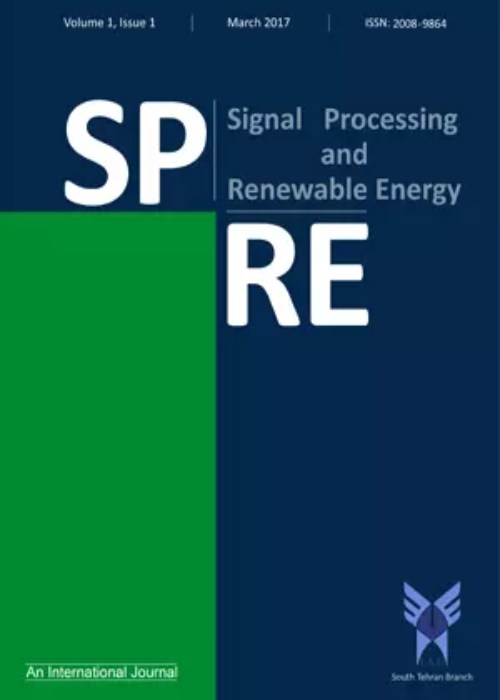فهرست مطالب
Signal Processing and Renewable Energy
Volume:1 Issue: 3, Summer 2017
- تاریخ انتشار: 1396/06/10
- تعداد عناوین: 6
-
Pages 1-11In this paper, the electrical distribution network reconfiguration to achieve loss reduction, load balancing and improve voltage profile in the presence of Distributed Generation (DG) with the gravitational search algorithm (GSA), is investigated. By choosing a 33-bus IEEE sample network and running a computer simulation on it, it is observed that the results of this rearrangement are comparable with similar papers.Keywords: Reconfiguration, distributed generation, Gravitational Search Algorithm
-
Pages 13-19Determining placement and capacity of reactive-power compensators in distribution networks is an optimization problem with various objectives and technical constraints. The large number of variables and constraints in this problem can be an obstacle for the success of classical and meta-heuristic optimization methods. Therefore, having a guess of the suitable buses for installing compensators as an initial solution, improves performance of the mentioned methods. Using the network impedance matrix, an initial guess is obtained in this paper in the form of suitable or higher-priority buses. The applied matrix is a revised version in which loads connected to the buses are taken into account. The reasons for considering the loads are that, firstly, the list of bus-priorities becomes more consistent with network load pattern, and secondly, difficulties in forming the impedance matrix in radial distribution networks are obviated. Comparison of the list of suitable buses for installing the compensator obtained by the proposed method with the list of buses extracted from the sensitivity analysis indicates the effectiveness of the former method.Keywords: Reactive-power compensation, Impedance matrix, Initial solution
-
Pages 21-26In this paper, at first, compressive sensing theory involves introducing measurement matrices to dedicate the signal dimension and so sensing cost reduction, and sparse domain to examine the conditions for the possibility of signal recovering, are explained. In addition, three well known recovery algorithms called Matching Pursuit (MP), Orthogonal Matching Pursuit (OMP), and L1-Norm are briefly introduced. Then, the performance of three mentioned recovery algorithms are compared with respect to the mean square error (MSE) and the result images quality. For this purpose, Gaussian and Bernoulli as the measurement matrices are used, where Haar and Fourier as sparse domains are applied.Keywords: OMP, MP, L1-Norm
-
Pages 27-37
This paper describes simplified modeling of metal oxide surge arrester (MOSA) to operate analysis. This model is a new model proposed (P-K Model) to verify the accuracy in order to compare with IEEE and Pinceti Model. The simulations are performed with the Alternative Transients Program version of Electromagnetic Transient Program (ATP-EMTP). In the present paper, the MOSA models were verified for several medium voltages which consist of 18 kV and 21 kV, which 18 kV arrester was used in 22 kV system of Provincial Electricity Authority (PEA) and 21 kV arrester was used in 24 kV system of Metropolitan Electricity Authority (MEA) in Thailand. The P-K model was evaluate from different manufacturing, it is based on the General Electric (GE), Siemens and Ohio Brass as well as IEEE and Pinceti Model. The tests are performed by applying a fast front current surge with front time of up to 0.5μs and the standard impulse current surge (8/20μs). The results were compared between three models in order to calculate the error operation of the MOSA in the ATP-EMTP Program. The relative error of arrester models show that the P-K model can be used to simulate and calculate in ATP-EMTP program as well as IEEE and Pinceti model. In the case of fast front current surge, the P-K model has a maximum error of 5.39% (Ohio Brass, 10 kA, 21 kV) and has a minimum error of 0.24% (GE, 10 kA, 18 kV). Also, the standard impulse current surge, P-K model has a maximum error of 2% (Ohio Brass, 10 kA, 18 kV) and has a minimum error of 0.32% (Siemens, 10 kA, 21 kV) in the voltage response.
-
Pages 39-48One of the main challenges in preventive maintenance scheduling in electric transmission network is obtaining the model which can evaluates the effect of the maintenance and inspection strategies on the component reliability. Such model, on one hand, should be able to consider the uncertainties of components deterioration and, on the other hand, should consider the effect of maintenance and inspection strategies on the deterioration. In this paper, using Markov model, six maintenance models are extracted. These models help us to determine the best maintenance strategy for each failure mode.Keywords: Preventive maintenance, Reliability, Markov Model, Failure Mode
-
Pages 49-59
In power systems, usually by lightning strikes or switching operation, impulse voltage is produced. This paper reviews the effect of high impulse voltage on the PD parameters. In recent years, numerous studies on PD in the insulation, under the impulse has been done. Despite the use of power equipment and tools, switching impulse is created in the system. So, studies on PD activity with the initiation and end voltage PD in insulators have been investigated. However, the combination of PD characteristics with AC and impulse has not been studied in many studies so far. Unlike previous studies, in this paper, along with the impulse voltage, the AC voltage effects are also considered. On the other hand, dielectric characteristics show the quality of insulation in terms of the soundness or deterioration of equipment over time. The deterioration and aging of equipment can be due to electrical stresses such as alternating current PDs or transient stresses or due to environmental pressures and temperature or mechanical pressures. At this point, the effect of the PD alternating current (AC) on paper combination insulation oil dielectric frequency response equipment is investigated. In this review, a brief history of the performance of insulation against partial electrical discharge is addressed, and the finite element method software (Maxwell) is used to simulate partial electrical discharge for objects that are particularly sharp.
Keywords: Partial Electrical Discharge, Insulation, Oil, Oil Paper, Dielectric Response


